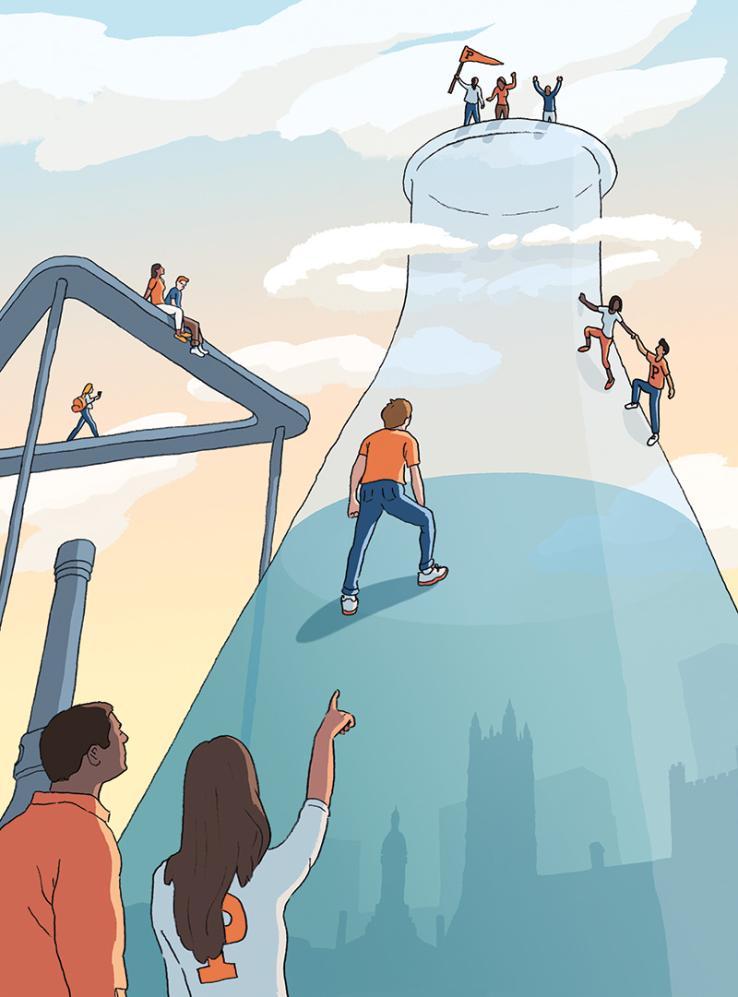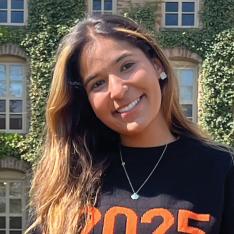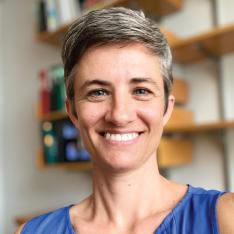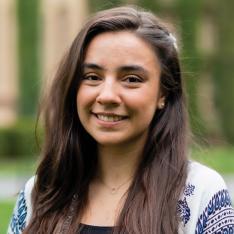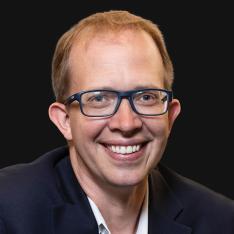In Claire Gmachl’s introductory physics class for engineers, first-year students work in teams to tackle problems such as: How much energy would a hyperloop (an ultra-high-speed transportation system proposed by Elon Musk) save, or how would melting polar ice caps affect the spinning of the Earth? Gmachl, a professor of computer and electrical engineering at Princeton, says the class, Mechanics, Energy, and Waves, is different from what incoming students would typically learn.
“In a classic physics lab, students might measure energy conservation in a roller coaster,” says Gmachl, who came to the University in 2003. “But in this class, we focus on how you would design a roller coaster to minimize energy loss to friction and air resistance, for example, and then measure it. So, it’s an interaction between science and engineering.”
Engineering is not the only department at Princeton where pedagogy is evolving. A year ago, a discussion grew about notoriously hard classes and how they were (or were not) evolving in the wake of New York University’s cutting loose organic chemistry professor Maitland Jones — who retired from Princeton in 2007 and is now an emeritus professor of chemistry — after students filed a petition claiming that his class was too hard. PAW spoke with students, faculty, and administrators to see how difficult classes at Princeton are being taught and found differences not only in engineering, but in organic chemistry and molecular biology. In each case, the expectations among students, and the responsiveness of professors to those students, are driving change in teaching and learning.
Says Martin Semmelhack, professor of chemistry since 1978, “It’s a matter of trying to change to match the audience.”
This will undoubtedly lead to questions about academic rigor from those who endured these so-called “weeder” classes. But reexamining the balance between pain and fulfillment among students — before and after the pandemic — is a concern not just at Princeton. The Wall Street Journal reported in September how “the world’s most competitive school systems” in Singapore, Japan, South Korea, and Taiwan are “easing up” on students to make learning more enjoyable.
Don’t worry. At Princeton, the classes are still hard. But as Amar Abou-Hussein ’25 says of taking organic chemistry, “It wasn’t as hard as it seemed at first. The professors make you feel like you have a fighting chance.”
Decades ago, lecture notes were the only resource for students taking orgo, the colloquial name for organic chemistry. Today, in addition to attending lectures and taking notes, students can access the professor’s lecture notes — “PDFs of the actual handwriting,” says Abou-Hussein — and videos of the lecture online. It’s one of several shifts, but something Abou-Hussein says “is not common at Princeton, and is really helpful.”
“I now remind myself that organic chemistry is just one of four, or even five classes a student is taking,” says Erik Sorensen, professor of chemistry and the other organic chemistry lecturer. Semmelhack and Sorensen acknowledge the pandemic’s detrimental effects on student learning and well-being and note that they have observed a greater spread in the preparation of incoming students. “We now obsess over exams and have adopted a more pro-student approach,” Sorensen says.
The teaching team of Sorensen, Semmelhack, and Sandy Knowles, director of the organic chemistry labs, meets and reflects on questions such as: When the students leave here, what should they know? What should be their experience? “I’ve always been aware of the impact of good teachers,” says Sorensen, drawing on his own story of getting hooked on chemistry because of a great teacher.
“We’ve cut some of the material from lectures,” says Semmelhack. “Not whole topics, but pieces of things.” And when designing exam questions, they add more scaffolding. “For example,” says Sorensen, “instead of asking the students, ‘In order to make this molecule, what would you start with?’” — a standard “synthesis” question in organic chemistry — “we now give them some possibilities to start with, almost like a word bank.”
Organic chemistry precepts now center on peer-group problem-solving, a “Maitland Jones philosophy,” says Semmelhack. About 10 years ago, the traditional attendance-optional mini-lecture format of the precept was shelved for an attendance-mandatory workshop-style class. Students work with graduate and undergraduate teaching assistants, and in some cases, one of the course instructors. “Precept is super important,” says Abou-Hussein. “It teaches you how to think about solving problems, and things that are fundamental in exams are taught in precept.” She speaks highly of the undergraduate TAs, who in addition to helping in precept, host review sessions before exams. “Since they are your peers, they are really there to help,” she adds.
Tom Silldorff ’23, a chemistry major now pursuing a master’s in education at Temple University, was one such undergraduate TA. A science lover ever since his eighth grade science teacher ignited a gummy bear into a fireball — “That was everything,” he says — he took orgo as a freshman at Princeton. The class is fundamentally different than anything he encountered in typical science classes, says Silldorff. “It’s more qualitative, it requires spatial reasoning [for thinking about molecular structures], and there are no equations to memorize,” he says. “Instead, you need to understand trends, patterns of molecular behavior. So you can’t come in and do what you always did — memorize and cram — and succeed.”
“My mission is to remove the memorization,” says Semmelhack, “and help the students understand the basic concepts.” And to understand, Silldorff says, students need to engage daily with the material to build up a comfort level. He likens it to learning a language. “When you master Spanish, you dream in Spanish. It has to be the same in organic chemistry.” Silldorff says it’s difficult to convince some students of this, but the message has a greater chance coming from an undergraduate TA. “We were involved very recently as students,” he says, “so we can confirm, ‘This is how you succeed.’”
Despite the changes in organic chemistry, its reputation as a hard class, if not the hardest class at Princeton, precedes it. “I think listening to the rumors hurt me,” says Abou-Hussein, who struggled in the first semester but got the hang of it in the second. “When you go into a class thinking it will be horrible, you tend to doubt yourself and underperform. But the professors make getting an A attainable.”
When speaking about the greater spread in student readiness in the engineering program, Houck isn’t fazed. In fact, he says it’s a mistake to wring one’s hands over it. “We’re teaching the best students in the country,” he says. “Sure, students coming into the school of engineering are coming in with different amounts of preparation, but all admitted students are capable of success.”
Still, sometimes students quit when the coursework gets tough. “If the challenge is in solving a problem with a real-world application, students are more likely to embrace the struggle,” Houck says.
In 2014, Houck led a committee to review the undergraduate courses offered by the engineering school. At that time, most of the freshman engineering students did not take any courses within the engineering school. And when first-year students withdrew from the engineering school, comments such as, “It wasn’t what I expected,” or “I didn’t like my engineering classes,” were often left. “What was interesting was that they hadn’t even taken any engineering classes yet,” says Houck.
Houck and a team of engineering faculty developed a new first-year course sequence, consisting of five courses, offered for the first time in the 2017-18 academic year through the Keller Center for Innovation in Engineering Education. The class was piloted with 30 students in 2017 and has since quadrupled in size.
To design the curriculum for his class, The Mathematics and Shape of Motion, Houck looked at Math 104, the traditional first-year math course, and talked to everyone who teaches a sophomore-level engineering course. “I said, ‘What do the students need to learn? What do they not need?’” Gmachl, who is also an adviser in engineering, says she regularly saw students who did not persist in engineering. “They were doing a lot of hard work — math, physics, chemistry, writing — without seeing where it was going,” she says.
Houck repeatedly emphasizes that any students who want to succeed in engineering can. “We aren’t here to weed people out,” he says. “The specific intent is to lift all boats, to lift all students.” Part of encouraging them, he says, is having explicit conversations with students about rigor. “We talk about how the role of a problem set in high school is to practice what you learn, whereas the role of a problem set in college is to wrestle with it.” Importantly, the new courses are not targeting the most prepared incoming students, who instead go directly to multivariate calculus and may take a sophomore-level engineering course. Instead, the ideal student is in the middle of the pack, and very likely has not had engineering exposure before.
Andra Constantin ’23 was one such student. “I didn’t know what kinds of problems engineers solved,” she says. Ultimately, she majored in computer science, within the engineering school, and credits the first-year courses with building her confidence. “The courses challenged my thinking and reasoning because we were solving real problems where there was sometimes not a ‘right’ answer. I thought back to how I succeeded in the classes when I faced challenges later,” she says.
Peter Bogucki, associate dean for undergraduate affairs in the engineering school, says that until recently, 25% or more first-year students who started in the B.S.E. program left the engineering school to pursue other majors. Now it’s around 18% overall, and 15% or less for students who have taken the first-year course sequence. “For some students, engineering isn’t the right path, and the new courses won’t change that,” he cautions, “but, for others, these courses show them what engineering is, and that can excite a student. And we are demonstrating to the engineering world that we can do this.” Bogucki adds that the new course sequence is just as rigorous as the traditional math and physics track. “The students who take these classes do just fine as sophomores,” he says.
“We’ve gone from a situation in which very few first-year students had exposure to actual engineering professors and concepts to now, when almost every student has the option to take some form of engineering in the first year,” says Houck. Beyond the earlier exposure to engineering, the students in the new sequence learn together as a cohort, something critical for success, according to Houck and Gmachl. Rather than being distributed among various intro math and physics sections, a group of students lives through the experience of first-year engineering together. “Through cohort building, we downplay competition and encourage collaboration,” says Gmachl, “which is more like real life, where engineers work in teams to solve problems.” Of her cohort, Constantin says, “it was one of the most important parts of the experience — we still have a group chat. There was no other class at Princeton with 70 kids where I knew everyone’s name. It made me feel like I had a home base.”
Across campus in molecular biology, Jodi Schottenfeld-Roames and Laurel Lorenz, both departmental lecturers, can relate to the importance of community building in science instruction. They teach molecular biology’s “core lab,” MOL 350, a required course for molecular biology majors during fall semester of their junior years (and select sophomores in the spring who plan to study abroad junior year). Intended to help students prepare for their senior thesis, Schottenfeld-Roames says, the class more generally shows students how to transition from textbook learning to research. “The mindset of the course is, what was the real process of science behind the textbook?” she says. Through studying the tracheal system in fruit flies, students learn how to ask a research question, how to read scientific papers, how to collect data using various lab techniques such as dissection, microscopy, precise gene editing, and how to write a research paper. “We want to ensure that every single student sees themself as a biologist,” she says.
How does the class accomplish this? Surprisingly, perhaps, by first focusing on community building. The professors form groups of three to four students who work together all semester. “We create diverse teams with diverse skill sets,” says Schottenfeld-Roames. She goes on to say that when she started, she received the advice that students should choose their own groups for comfort level. But, she says, “that was not ideal. It didn’t help all students in the course use the skills needed to effectively collaborate and develop as scientists.” Lorenz adds, “I think about group work in terms of leadership skills, and stress that skills like listening, critical thinking, and implementation are part of being leaders.” Students in the class speak highly of the approach. Says Victoria Merengwa ’24, “I loved the group work. Regardless of background, it was like, ‘OK, we are all in this together!’”
Early in the class, Lorenz introduces students to an assignment adapted from a 1950s National Public Radio program called “This I Believe.” Students reflect on questions such as: What brought you into science? What keeps you persisting, moving toward your goals? “This helps build connection and allows students to think about the unique perspectives they bring into the class,” Lorenz says. Schottenfeld-Roames has aimed to build connections outside of the classroom, with senior undergraduate course assistants for the junior core lab class and an undergraduate colloquium in which seniors majoring in molecular biology present their work. “Every time you talk about science, it helps. And it’s a no judgment zone. Every question matters,” she says.
Says Maryam Kamel ’23, who is a research technician in the department of rehabilitation and regenerative medicine at Columbia University, “Schottenfeld-Roames and Lorenz have built a community of molecular biology majors — I knew my cohort so well.” Says Jason Hong ’22, who is in an M.D.-Ph.D. program at the University of Pittsburgh and Carnegie Mellon University, “Before undergraduate colloquium, I had worked in two labs and never said a word in lab meeting. However, last year, I found myself actively contributing to discussions on various research projects and asking many more questions during my NIH post-bac research experience.”
The students learn to be scientists with assignments that teach them how to read and write and research papers, but, says Schottenfeld-Roames, “We recognize there are different learning styles in the classroom, and we give students different opportunities to demonstrate their understanding of the science.” For example, instead of an oral presentation that had to be in the classroom, students may now make a video of themselves standing in front of a chalkboard presenting, flipping through a PowerPoint presentation, or doing a live sketch, Khan Academy-style. “We also give lots of low-stakes assignments throughout the semester in order to provide regular feedback,” she adds. “The daily engagement forced me to keep up,” says Merengwa. “I had to do something every day of the week.”
And lest anyone bemoan any rigor that may be lost with a focus on community building, support, and accommodation of different learning styles, Hong says, “Everything I’m hearing as an incoming M.D.-Ph.D. student, I learned three years ago in core lab. We hear about framing a story in science — what do we know? What do we not know? We did that in core lab. It prepared me to think like a scientist.”
From these three classes at Princeton, a story emerges. Students have changed. Some might see them as more demanding, more in need of praise, less willing to struggle alone. On the flip side, they want to learn — but maybe not the same way their parents learned — work in a collaborative environment, and ultimately change the world. And with more diverse student bodies come students with different levels of preparation.
This isn’t a challenge unique to Princeton, says Allison Slater Tate ’96, whose husband and father are alums and whose son is in the Class of ’25. Slater Tate is director of college counseling at Lake Mary Preparatory School in central Florida and says over the past three decades, “We have widened access to higher education but are now facing the challenge of supporting brilliant students who face vast inequities in high school preparation and helping them succeed.”
COVID has only exacerbated such inequities and made the job of college admissions teams harder, says Ed Venit, managing director at the EAB, a Washington, D.C.-based consulting firm specializing in education. “High school grades assigned in 2020 and 2021 may not be as precise as an indicator as they had been previously,” he says, as schools in various combinations of remote or hybrid scenarios had to assess students differently.
Karen Richardson ’93, dean of admission at Princeton, echoes these sentiments. “Our job and our goal is to bring in students who we believe can be and will be successful here, academically.” Richardson herself was one of those less-prepared students, coming to Princeton 30 years ago, “from a tiny public high school that didn’t offer AP courses,” and was part of a program similar to today’s Freshman Scholars Institute, offered through the Emma Bloomberg Center for Access and Opportunity. The center provides support to students who are heading to Princeton with fewer resources, starting with a summer program to get acclimated to campus and the rigor of Princeton. “This helps us get students to and through Princeton,” Richardson says.
Steve Dandaneau, executive director of the Association for Undergraduate Education at Research Universities and associate provost at Colorado State University, says for institutions to be successful, “Equity and excellence can’t be divided.” He says some students may have deficits in academic preparation but assets in other areas, and getting rid of the deficit thinking will change the way people learn.
We may already be watching this now at Princeton, in organic chemistry, first-year engineering, and molecular biology core lab. In each case, the professors have reflected on what they are seeing and hearing from students. Instead of relegating such sentiments to a “kids today” attitude, the professors have addressed them and are teaching reshaped classes that are just as rigorous as earlier versions.
Venit talks about systems profiled in the book Antifragile, by Nassim Nicholas Taleb, in which stress makes systems such as muscles, for example, stronger. “Maybe it will turn out that higher education is one such system,” he says, and stress from generational change, the pandemic, and other factors, “will have created something better than would have come about otherwise.”
Susan Reslewic Keatley ’99 majored in chemistry and is now a writer and host of the podcast Science Fare.

